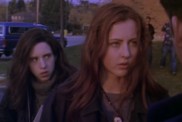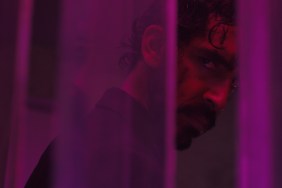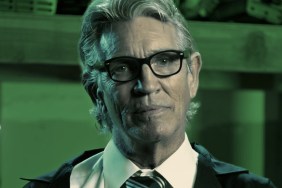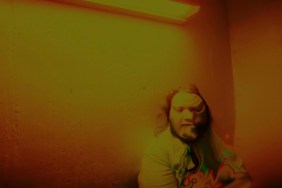
“Director Terrence Malick recommends that The Thin Red Line be played loud.”
Outside of the packaging indicating Criterion’s high definition transfer of The Thin Red Line was supervised and approved by director Terrence Malick and cinematographer John Toll, the above sentence is the only other contribution Malick makes to this release. Considering Criterion has put together one of the most stunning high definition transfers of one of the most beautiful films out there and on top of that provides a DTS-HD Master Audio 5.1 track I guess we can’t ask for much more. Yet, that’s exactly what we get, more. Criterion provides hours of brand new bonus material to keep you busy for days. This is one of the best new releases Criterion has put out in 2010 and it’s the release fans of this film were hoping for.
Believe it or not, I hadn’t seen The Thin Red Line before November of last year. At that time I wrote up my thoughts in my What I Watched column, and considering the amount of special features on this disc I think I’ll let those thoughts speak for my opinion of this film so we can move along. Here’s a snippet from that write up:
I honestly think I could write for days about this film, a film I didn’t watch in 1998 because I was told it was boring… Boring? This film is about as intense as they come and on top of that it isn’t your stereotypical, cliched war film.
Addressing issues of “life and death” and “good and evil” with a bend toward nature there are several messages that can be taken away from this film. I will admit, at nearly three hours there isn’t a lot left to decipher by the time the film is up, but there are so many different metaphors used along the way it opens up new comparisons as you go.
We are witness to a battle wounded baby bird midway through the film only to have the frequent voiceover dissecting its appearance toward the end coming to the conclusion that “death has the final word,” which is a line I found particularly important since the most prominent message I got from the film was that even once the battle is over, people are still alive. In short, it appears the soldiers that die along the way are getting off easy.
This is portrayed in several different instances and even debated as Nick Nolte’s war-mongering will offer up one outcome, later referred to by voiceover as the side that “feels the glory,” compared to Elias Koteas’ well-thought-out, preservation-of-life tactics. Another example comes in the form of language as an American soldier tells a Japanese soldier he’s about to die in English, only to have that soldier yell back in his face in Japanese. Something that typically would only suggest an inability to converse. immediately becomes menacing. When the man who was just told he is dying musters up the resolve to yell right back and you can’t understand a word he is saying there is something terribly frightening about what is unknown at that moment.
Now consider we’re talking about a film that made only a fraction of what Steven Spielberg’s Saving Private Ryan made and both films lost to Shakespeare in Love for the Best Picture Oscar. Truth be told, I am a huge fan of Shakespeare in Love, but there’s no way I could write the same kind of thoughts about that film as I just shared with you concerning The Thin Red Line or what I recently wrote about Saving Private Ryan after its Blu-ray release. I’m not going to argue which film should have won the Oscar, primarily because I don’t think there is much of an argument.
But let’s leave that alone for now and get back to the disc at hand. The special features included here are numerous and they will have you drooling for more.

Interview segments totaling over 90 minutes are broken up into four sections: Actors, Casting, Editors and Music. In the 34-minute long “Actors” section you’ll hear Sean Penn in all his arrogant glory. Elias Koteas will tell you this is a film that changed him as there’s life “before Terry Malick and after Terry Malick,” and damn near every one of them has a different way of imitating Malick and offering insight as to what it was like to work for the man.
The “Casting” section is a natural next step as casting director Dianne Critended discusses her pre-production work and offers up glimpses of some rare audition footage. You’ll see auditions from folks that didn’t make the cut such as Crispin Glover, Josh Hartnett, Philip Seymour Hoffman and Luke Perry as well as footage from those that did including Ben Chaplin, Thomas Jane, Elias Koteas, Dash Mihok, John Savage, and Nick Stahl.
My favorite of the four, however, is the “Editors” section. It’s the most revealing following the actors discussion of how they had to give themselves over to Malick’s way of making a film and simply be ready for when he calls on them. For the editors, it was a grueling process as Leslie Jones, Saar Klein and Billy Weber discuss every step in the year and a half it took to edit the project. Weber said he had to force Malick to watch the first five hour cut and still believes it was the only time he watched the movie from beginning to end before it was released.
The editors were working with over one million feet of film and when you consider 6,000 feet is an hour of footage that means they were sorting through over 166 hours of film. That’s a lot and Weber’s advice for future editors working with Malick is to say, “Nothing will ever be this hard again, and any movie you cut after this will always seem easy.”

Things don’t get any easier on the musical end as Hans Zimmer then discusses his score in the 17 minute “Music” section and how Malick wasn’t afraid of the score as many other directors seem to be and how the two would argue over the meaning of a minor third to an open fifth. The focus on music is continued with “Melanesian Chants,” a selection of songs running for seven minutes and playing over production stills from the film.
The final interview piece is with Kaylie Jones, daughter of James Jones whom wrote the book the film is based on. Among other things, Jones discusses her father’s book and the lifestyle she was raised in. She also mentions that out of all the characters in the film, she believes Fife, played by Adrien Brody, most closely resembles her father.
Additionally there are 15 minutes of authentic World War II newsreels detailing the fight in Guadalcanal and just over 13 minutes of outtakes featuring eight different scenes. In these you’ll see Mickey Rourke’s excised performance, John C. Reilly gets a little more time, Nick Stahl kills a Japanese soldier, there’s an exchange between Ben Chaplin’s character and George Clooney and Fife (Brody) gets sent home. All are in rough form and a couple are a little choppy, but considering the original cut was five hours long and we are only getting a look at about 14 minutes here, it makes me wonder just what else is missing considering the likes of Bill Pullman and Lukas Haas all had their roles in the film cut from the final release. Where is that footage?
The package is capped off with a 36-page illustrated booklet containing a variety of essays and an audio commentary recorded exclusively for this release with production designer Jack Fisk, producer Grant Hill and cinematographer John Toll. Both are just as great as you’d expect them to be and make you feel as if you are holding something special in your hands.
I can’t say enough about this release. The film and the features are intoxicating. You can’t help but continue to watch and it’s one Criterion release you will gladly pay the Criterion price.










